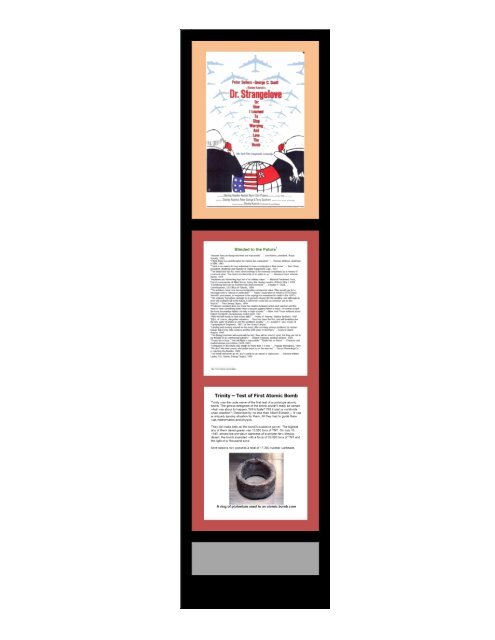- Page 1 and 2:
The Gallery of Clean Energy Inventi
- Page 3 and 4:
Disclaimers Inclusion of any invent
- Page 5 and 6:
“Gallery of Clean Energy Inventio
- Page 7 and 8:
For example the “16 Larger Genera
- Page 9 and 10:
Price totals from moviepostershop.c
- Page 11 and 12:
Interstellar 11” x 17” Framed $
- Page 13 and 14:
Torsion Field Smaller Generators Sp
- Page 15 and 16:
The “Die 4: Revolution! Energy Au
- Page 17 and 18:
1.5 meters H45 Gallery of Clean Ene
- Page 19 and 20:
.75 meter H45 Local Student Art .75
- Page 21 and 22:
Thank You for signing our guest reg
- Page 23 and 24:
↑ .5 meter H45 24.5 inches ← .5
- Page 25 and 26:
↑ 24.5 inches 2.75 meters H45 8
- Page 27 and 28:
↑ 24.5 inches 3.5 meters H45 8’
- Page 29 and 30:
↑ .5 meter H45 24.5 inches ← .5
- Page 31 and 32:
The detailed top view of the smalle
- Page 33 and 34:
↑ 24.5 inches 3 meters H45 8’ P
- Page 35 and 36:
↑ 24.5 inches .5 meter H45 ↓
- Page 37 and 38:
Advanced Self-Powered Electric Tran
- Page 41:
Hydro-Magnetic Dynamo Hydro-magneti
- Page 45:
Hydrino Generator BlackLight Power
- Page 49:
Thorium Power Pack The thorium powe
- Page 53:
Induction Coil Coating Increases Ge
- Page 57:
Ball Lightning and Self-Confined Th
- Page 61:
Direct Energy Conversion Power gene
- Page 65:
Plasma Biomass Gasification Plasma
- Page 69: Super Steam Technology The ‘super
- Page 73: References: Four files - 153 pages
- Page 80: Magnetic Drive Generator The magnet
- Page 84: Multask Dome Multiple Output Omni-D
- Page 88: Advanced Solar Photo-Voltaic Crysta
- Page 92: Casimer-Layered Electrodynamic Gene
- Page 96: Hybrid Cold Fusion Hydrogen Reactor
- Page 100: LUMELOID Light-Polarizing Photovolt
- Page 104: N-1 Homopolar Generator Bruce DePal
- Page 108: Switched Energy Resonant Power Supp
- Page 112: Maximum Velocity Turbine Wind turbi
- Page 116: Nova Phase Change Engine The Nova p
- Page 122: Energy Catalyzer Both uranium fissi
- Page 126: Thermoelectric Generator With over
- Page 130: Reactionless AC Synchronous Generat
- Page 134: Laser-Induced Fusion in Ultra-Dense
- Page 138: References: A file of 153 pages of
- Page 147: AuroraTek’s Self-Charging Electri
- Page 151: Conical Vortex Heat Exchange Engine
- Page 155: Torsion Field Radio Most drivers be
- Page 159: Nickel-Iron Battery The nickel-iron
- Page 163: Low-Temperature Diamond or Titanium
- Page 167: IPMS High-Temperature Gas Plasma De
- Page 171:
Salt Water Flow Cell Car NanoFlowce
- Page 175:
IPMS Crystal Lattice Energy Storage
- Page 179:
Catalyst Induced Hydrino Transition
- Page 183:
Walden Amplified Magnetic Motor Mic
- Page 187:
Sky Train Sky Train Corporation’s
- Page 191:
Electrostatic Motor Rather than rel
- Page 200 and 201:
Middle signboard is white, 29-1/2 i
- Page 202:
Trinity - Test of First Atomic Bomb
- Page 207:
Deep Underground Burial of Radioact
- Page 211:
Methods of Influencing Radioactivit
- Page 215:
Piezonuclear Reactions in Solutions
- Page 219:
Combining Brown’s Gas with Buckin
- Page 223:
Barker’s Radioactivity Remediatio
- Page 227:
‘Hutchison Effect’ for Neutrali
- Page 231:
RIPPLE Fission The RIPPLE fission p
- Page 235:
AmoTerra Process The AmoTerra proce
- Page 239:
Photo-Remediation The photo-remedia
- Page 243:
Refresher-Regenerator A ‘refreshe
- Page 247:
Method, System and Apparatus for Co
- Page 251:
Kervran Reactions The very compelli
- Page 255:
Wilhelm Reich’s Oranur Effect Met
- Page 259:
Graphene Oxide can Decontaminate Ra
- Page 263:
References: Two files, 237 pages of
- Page 268:
Middle signboard is white, 29-1/2 i
- Page 273:
Magneto-Gravitational Converter (Se
- Page 277:
David Burns’ Anti-Gravity Flying
- Page 281:
Inertia Reduction, and Possible Imp
- Page 287:
Domestic Lens The Domestic Lens is
- Page 291:
Magnetic Vortex Drive Engine Magnet
- Page 295:
Space Drive Engine The space drive
- Page 299:
Ground Transportation for Colonies
- Page 303:
Torsion Field may ‘Uncurve’ Spa
- Page 307:
IPMS-Chernovitsky Super Ceramics Ki
- Page 311:
Tubular Shaped Interstellar Space C
- Page 315:
Walden Inertial Propulsion System T
- Page 319:
Internal Rotating Plasma Rings Inte
- Page 323:
Proxima Centauri, Nearest Star to S
- Page 345:
Middle signboard is white, 29-1/2 i
- Page 350:
Hydrosonic Pump The hydrosonic pump
- Page 354:
Primary Water Japanese laboratory e
- Page 358:
Atmospheric Water Generation An unl
- Page 362:
Environmental Heat Engines At least
- Page 366:
Researchers Discover Massive Freshw
- Page 370:
Solar-Powered Watly Provides Intern
- Page 374:
NanoCeram Water Purification Techno
- Page 378:
The Drinkable Book The Drinkable Bo
- Page 382:
High-Tech Water Treatment Engineers
- Page 386:
LifeSaver Inline Pump Water Filters
- Page 390:
References: Three files - 153 pages
- Page 397:
Middle signboard is white, 29-1/2 i
- Page 402:
Segment and Segment Test A segment
- Page 406:
Series Prerequisite Chart The midte
- Page 410:
Student Credit Load Calculation Cre
- Page 414:
Segmented Course Weekly Progress Re
- Page 418:
Series Eligibility Table Each serie
- Page 422:
Series Scheduling Schedule The sche
- Page 426:
CRITICAL PATH METHOD The structure
- Page 430:
Student Interest Groups A solution
- Page 434:
Overall System Hardware Configurati
- Page 438:
Master Network Control Center The m
- Page 442:
Student Input/Output Functions Appr
- Page 448:
References: A 125-page “Torsion F
- Page 462:
Kervran Reactions, 146 Laser-Induce
- Page 465 and 466:
Gallery of Clean Energy Inventions
- Page 467 and 468:
Moe-Joe Orgone Energy Cell This Moe
- Page 469 and 470:
Inventions and Images Credits (The
- Page 471 and 472:
Direct Energy Conversion. The figur
- Page 473 and 474:
Casimer-layered electrodynamic gene
- Page 475 and 476:
Energy catalyzer. The text and the
- Page 477 and 478:
Torsion field radio. The text is a
- Page 479 and 480:
Melanin Battery-Generator. The text
- Page 481 and 482:
Piezonuclear reactions in solutions
- Page 483 and 484:
Refresher-regenerator. The text is
- Page 485 and 486:
Orgone energy accumulators may impa
- Page 487 and 488:
Tubular shaped interstellar space c
- Page 489 and 490:
Water purification with electrical
- Page 491 and 492:
High-Tech Water Treatment. The text
- Page 493 and 494:
Guest Submitted Comments or Questio
- Page 495 and 496:
There's been a huge amount of inter
- Page 497 and 498:
Coincidence or further evidence of
- Page 499 and 500:
And this juicy new bit about neutri
- Page 501 and 502:
Even Californians doubt Arizona wou
- Page 503 and 504:
To their credit, some environmental
- Page 505 and 506:
No more bailouts. Not for banks. No
- Page 507 and 508:
Now here is a CRAZY idea.. and bear
- Page 509 and 510:
Gary, As far as I and a few associa
- Page 511 and 512:
applause of “all the people who m
- Page 513 and 514:
Comment: Boulder City, Nevada has a
- Page 515 and 516:
04:15 PM EST on December 10th, 2015
- Page 517 and 518:
03:44 PM EST on August 31st, 2015 |
- Page 519 and 520:
Alpha radiation is one of four majo
- Page 521 and 522:
The exhibition was announced in the
- Page 523 and 524:
Recent studies confirm “exposure
- Page 525:
Postscript: “The future of the Ol
















